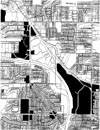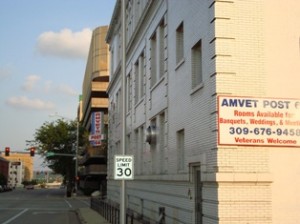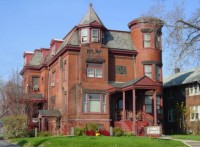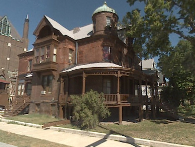According to this week’s “Issues Update” from the City, historic landmark applications in Peoria are up.
“In the past two years, 2007 and 2006,” the report states, “a total of two landmark applications were filed for Irving School and Glen Oak Park.” In 2008, however, there have been four: Amvets Post #64 (237 NE Monroe), Hamilton Boulevard, 401 NE Monroe, and Family House Peoria (1509 N. Knoxville).
For those of you who can’t picture these buildings, here they are — respectively, the Amvets building, Family House, and 401 NE Monroe:
Generally, I see this as a good thing. Too much of Peoria’s history has already been razed. What’s left really should be preserved — presuming, of course, that it meets reasonable standards for preservation. Most of these properties do.
The one exception would be Hamilton Boulevard. This is on the council’s agenda for Tuesday night. What they are actually proposing be given landmark status is “the built median component of the right-of-way, located within Hamilton Boulevard, from Monroe Street to Glendale Avenue, and Randolph Avenue to North Street.” To which I ask, The median? Really?
The justification for this appears to be the fact that the street was laid out by William S. Hamilton, son of Alexander Hamilton (you remember Alexander Hamilton — the guy on the $10 bill, first Secretary of the Treasury, died after famous duel with Aaron Burr). Okay, sure, William Hamilton is a prominent historical figure in Peoria. But he also laid out Water, Washington, Adams, Jefferson, Madison, Monroe, Liberty, Main, and Fayette. Should we also landmark all of those streets?
Besides, they kind of undercut their whole preservation argument when they removed the portion of Hamilton that is slated to be changed for the Methodist Hospital expansion. Les Kenyon of the Central Illinois Landmark Foundation (CILF) is quoted in the Historic Preservation minutes as saying:
…they [CILF] are satisfied that Methodist Hospital will provide a beautiful environment for patients, medical staff and visitors as they travel on the Hamilton corridor. He went on to say that for this reason, they have amended their original position with regard to Methodist Hospital’s plans and withdraw any objection to the Methodist Plan regarding landmarking Hamilton Boulevard through the Methodist campus and want to remove the Methodist campus from their landmark request.
But Methodist Hospital is removing the built median that CILF wants to see landmarked on the rest of the boulevard. So, is it historic or not? And Methodist is narrowing Hamilton where it passes their institutional zone. So, is the width of the street worth preserving or isn’t it? If Methodist’s plans for Hamilton don’t destroy the historic nature of the boulevard, then nothing does, and thus it needn’t be landmarked.
But don’t get me wrong. Even though I question this one landmark request, overall I think preserving Peoria’s built history is important. I was recently reading some newspaper clippings about the razing of the Rialto Theater to make way for the Civic Center, and it made me sad. It was one of Peoria’s original vaudeville houses. Originally called the Hippodrome, it housed many famous acts, as did the Palace Theater which was also razed about the same time. Whereas other cities, like Chicago, preserve their historic theaters, Peoria tore theirs down and felt the Civic Center theater was an adequate replacement. What a shame.
I’ve often joked (morbidly) that any history museum in Peoria should include an interactive exhibit where visitors can sit in a little crane and swing a wrecking ball into models of Peoria’s historical landmarks. It would be an object lesson in how little we value our history.
 On July 22, the council approved a huge addition to the city’s Enterprise Zone (EZ). Click on the thumbnail to the right for a map of the parcels added then. You’ll notice that those parcels include, among other things, Westlake Shopping Center, all of the “convenience loan” establishments along University, Wal-Mart, Auto Zone, Comcast Cable, and Best Buy.
On July 22, the council approved a huge addition to the city’s Enterprise Zone (EZ). Click on the thumbnail to the right for a map of the parcels added then. You’ll notice that those parcels include, among other things, Westlake Shopping Center, all of the “convenience loan” establishments along University, Wal-Mart, Auto Zone, Comcast Cable, and Best Buy.










